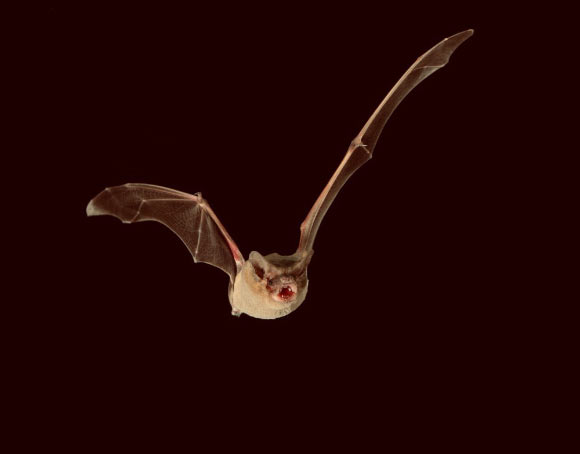A study published in the journal Royal Society Open Science shows that the Brazilian free-tailed bat can achieve flight speeds of 100 mph (160 km per hour) — faster than those previously documented for any bat or bird.

The Brazilian free-tailed bat (Tadarida brasiliensis) can reach record-breaking speeds, according to McCracken et al. Image credit: Max Planck Institute for Ornithology.
Swifts, like the common swift (Apus apus), which can reach speeds of 68 mph (110 km per hour), are considered the fastest birds in the world at horizontal flight.
In contrast, due to their wing structure, bats generate greater resistance, and are generally considered slower flyers.
The new study, led by Prof. Gary McCracken of the University of Tennessee, Knoxville, demonstrates otherwise.
Prof. McCracken and his colleagues from Boston and Brown Universities, the Max Planck Institute for Ornithology and the University of Konstanz conducted the study in southwestern Texas using a novel airplane tracking method.
The researchers caught seven Brazilian free-tailed bats (Tadarida brasiliensis) as they emerged from the entrance of the Frio Cave at night. They then attached tiny radio transmitters to bats’ backs using surgical glue.
Until now, the fastest bird records were collected during short flight segments using tracking radar and high-speed video.
Prof. McCracken and co-authors used an airplane to follow the complete flight track of the bats. They followed one bat per night.
“It was not easy for the pilot to follow the fast-flying animals so that we could localize them accurately and measure their flight path continuously,” said study co-author Dr. Dina Dechmann, from the Max Planck Institute for Ornithology.
The team’s models indicate that tail winds did not assist the bats’ flight speed.
The authors observed that the bats did exactly what airplanes and birds do, depending on wind conditions.
“When they have a headwind, they fly faster. When they have a tailwind, they slow up. This is exactly what has been demonstrated in other flight machines, from airplanes to birds,” Prof. McCracken said.
“Initially, we could hardly believe our data, but they were correct: at times, the female bats, which weigh between 11 and 12 grams, flew at speeds of 100 mph — a new record for horizontal flight,” added co-author Dr. Kamran Safi, also from the Max Planck Institute for Ornithology.
“The findings suggest a reevaluation of the performance abilities and capabilities of bats. Their flight performance has been underappreciated,” Prof. McCracken said.
_____
Gary F. McCracken et al. 2016. Airplane tracking documents the fastest flight speeds recorded for bats. R. Soc. open sci. 3, 160398; doi: 10.1098/rsos.160398







